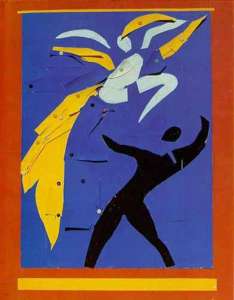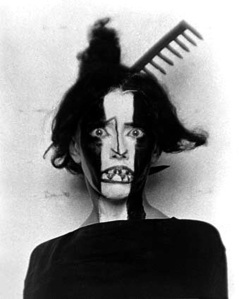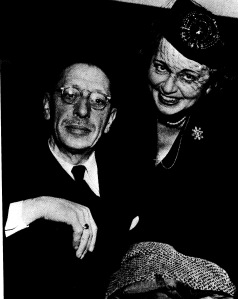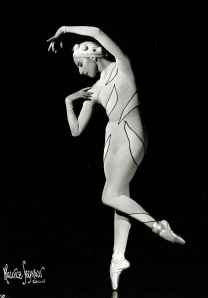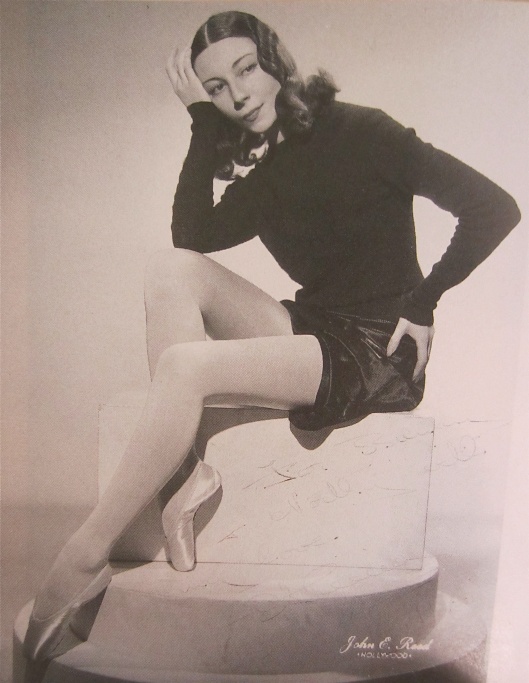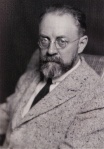Tags
Alicia Markova, Andre Eglevsky, Ballet Russe de Monte Carlo, Ballets Russes, Chatting with Henri Matisse:The Lost 1941 Interview, George Balanchine, Grace Robert, Henri Matisse, Isadora Duncan, John Russel, L'Etrange Farandole, La Dance, Le Chant du Rossignol, Leonide Massine, Martha Graham, Matisse Cut-Outs, Matisse: Father & Son, MOMA, Pierre Courthion, Rouge et Noir, Serge Diaghilev, Tamara Karsavina, Tate Modern, The Borzoi Book of Ballets, The Nightingale
“There are no second acts in American lives,” wrote F. Scott Fitzgerald. Fortunately, celebrated artist Henri Matisse was French. Wheelchair bound after debilitating stomach cancer surgery in 1941, the 72-year-old picked up a pair of scissors and never looked back.
“I came within a hair’s breadth of dying,” Matisse told Swiss art critic Pierre Courthion at the time. “Long live joy . . . and french fries!” (You can read the entire fascinating interview in a recently released book from Getty Publications.)
That new lease on life led to a jubilant new art form, currently on view in the exhilarating exhibit Matisse Cut-Outs at London’s Tate Modern (moving on to New York’s MOMA in October). “Bold, exuberant and often large in scale, the cut-outs have an engaging simplicity coupled with incredible creative sophistication,” the Tate makes clear.
Matisse had actually begun experimenting with painted paper cutouts just prior to his illness while working on the Barnes Foundation “Dance” mural and a Ballet Russe de Monte Carlo production called Rouge et Noir, which, incidentally, premiered 75 years ago this month. Choreographed by Léonide Massine, the work was a dramatic allegorical ballet set to Dmitri Shostakovich’s First Symphony. Matisse’s new use of cut-outs would become integral to the design, begun in 1938. Matisse went so far as to pin cutout shapes directly onto Massine’s star ballerina – Alicia Markova!
Massine was mulling over Rouge et Noir when he made one of his frequent visits to Matisse’s studio. Off in the corner were the artist’s “Dance” mural mock-ups for the Barnes Foundation in Pennsylvania. From the Making of Markova:
Massine recalled, “I pointed out to him [Matisse] that they were very similar in conception to the ballet I was planning, which I visualized as a vast mural in motion, he became suddenly very interested.”
The high vaulted arches would become the formative background element in the backdrops for Rouge et Noir.
Matisse then produced a series of boldly colored mockups of his proposed set and costume designs by combining gouache and cut paper shapes painstakingly adjusted until perfect, then thumbtacked in place.
Massine was so taken with Matisse’s work on the ballet that he had the artist boldly sign his name in large black lettering on the Rouge et Noir front curtain. The choreographer wanted the audience to know, even before the ballet began, who was responsible for the awe-inspiring design.
According to Grace Robert in The Borzoi Book of Ballets: “The most exciting feature of Rouge et Noir [briefly called L’Etrange Farandole] is the décor by Henri Matisse. The setting consists of a backdrop and several flat arches painted in primary colors, in front of which dancers dressed in suits of fleshings in red, blue, yellow, and black, with headdresses that covered their hair (with the most important group, including Man and Woman, in white), ebbed and flowed in changing patterns. It was extraordinarily effective scenically . . . The groups formed and came apart, making wonderful blocks of color like an abstract painting set in motion.”
As I explained in The Making of Markova: Once again the themes were monumental: man and woman battling the spiritual and material worlds, with current political overtones. There was also a battle between Massine and his dancers, as his choreography was tremendously difficult (and often physically painful) to master. “On the call-board the first day, were three names – Theilade, Slavenska, Markova,” wrote dance critic Mary Mack of The Music News. “As the work progressed, two names were dropped, Markova remained.”
In discussing the process of learning new choreography, Markova confessed. ”I’ve rehearsed for a new ballet and haven’t been able to walk for two days.” She used Massine’s Rouge et Noir as a case in point:
“He decided he wanted to blend the classical technique with [Isadora] Duncan from the waist up, with acrobatics and some [Martha] Graham. That’s what I had to reproduce for him. The first day my legs were black and blue. I had two large black marks on my hips.
The second day, since my leggings had been splintered whenever I hit the wood floor, I came back wearing linen slacks. For the whole of the rehearsal for the ballet Rouge et Noir, I used to put cotton wool to pad my hip bones. I had kneecaps on, and I used to put a pair of linen slacks over the lot. I was well upholstered!
When it came time for the performance, all I had on was just white silk tights all over, no padding. I learned by that time where to put the strength, how to try to get the most effect and save myself. But even then, I used to have pads in the dressing room with witch hazel when I came off. There again, you see, I was willing to be bruised black and blue for Massine to achieve choreographically something superb. Now there were many dancers in the company who wouldn’t do it. This isn’t really fair.”
Grace Robert certainly felt Markova’s efforts were worth it: “As long as Alicia Markova was Woman, Rouge et Noir had a strong emotional impact. A very abstraction of womanhood, yet she wrung the heart with her magnificently understated agony in the face of loss and adversity – a symbol and precursor of the hell that was already breaking out in Europe, to spread all over the world. As she was succeeded in this role by a dancer of considerably less (to put it charitably) artistic stature, Rouge et Noir lost any interest except as a piece of stage decoration.” But what a stage decoration!
Rouge et Noir was not the first time Massine and Matisse had collaborated on a ballet. In 1919 the two met at the famed Ballets Russes, where the unimaginably persuasive Serge Diaghilev talked a reluctant Matisse into designing Massine’s production of Le Chant du Rossignol (The Song of the Nightingale), with music by Igor Stravinsky. Though his rival Picasso had been working on sets and costumes with Diaghilev for years, Matisse didn’t want to take time away from his painting. “But I’ll only do one ballet and it’ll be an experiment for me,” he would later explain to Pierre Courthion. “And so I learned what a stage set could be. I learned that you could think of it as a picture with colors that move.
“These colors are costumes. The colors move, but they mustn’t alter the expression conveyed by the set. They must be subordinated to a single grand expression and be able to interact without wrecking the harmony of the rest. The choreographer, Massine, was a great help to me; he understood my notion perfectly.”
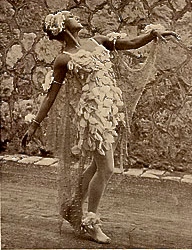
The feathers on the Matisse-designed Nightingale costume for Tamara Karsavina moulted off on opening night!
Unfortunately for Matisse, “the dressmakers said that they couldn’t understand his sketches,” according to John Russell’s Matisse: Father & Son. “Tamara Karsavina, who had the role of the live Nightingale (as opposed to the mechanical one), said that on the first night the feathers moulted off her costume.”
Though it looked sumptuous, the 1920 ballet was a flop. But four years later, the perennially broke Diaghilev decided Matisse’s designs were too beautiful to waste. All-new choreography was in order, and it was to be the first major effort from an untried 20-year-old talent – George Balanchine. Karsavina was replaced by the 14-year-old Alicia Markova, the youngest ever soloist at the company, with Matisse asked to create her new costume.
While Markova was dreamily picturing a brown feathered bird tutu, Matisse had other ideas. Uncharacteristic for the King of the Fauves, he dressed Markova in an all-white unitard head-to-toe with white osprey feathers covering a close-cropped bonnet. (For more on that amusing costume story, see my former post Alicia In Wonderland.) Balanchine’s Nightingale – with daring choreography for the young dance prodigy Markova – was a hit. Remarkably, Matisse would once again clothe Markova in a white unitard for Rouge et Noir some fifteen years later.
When one thinks of artists and the ballet, Degas instantly comes to mind for his paintings and pastels, and perhaps Picasso for his set and costume designs. But during the time Matisse worked with Markova on The Nightingale, he too fell under the spell of ballet, producing a series of ballerina drawings called “Ten Dancers,” as well as several luscious Ballet Dancer oils.
However, Matisse had always been fascinated by the movement of dance, which he celebrated throughout his career in some of his most superb large scale works.
“For me, a color is a force,” he told Pierre Courthion. “My pictures are made up of four or five colors that collide with one another, and the collision gives a sense of energy.”
From his early dynamic Fauvist paintings to his delightfully original cut-outs, Matisse taught colors how to dance.


